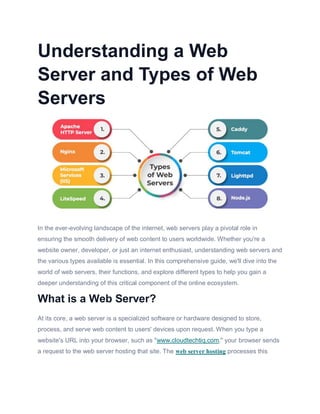
Web Server Types - Understanding a Web Server
- 1. Understanding a Web Server and Types of Web Servers In the ever-evolving landscape of the internet, web servers play a pivotal role in ensuring the smooth delivery of web content to users worldwide. Whether you're a website owner, developer, or just an internet enthusiast, understanding web servers and the various types available is essential. In this comprehensive guide, we'll dive into the world of web servers, their functions, and explore different types to help you gain a deeper understanding of this critical component of the online ecosystem. What is a Web Server? At its core, a web server is a specialized software or hardware designed to store, process, and serve web content to users' devices upon request. When you type a website's URL into your browser, such as "www.cloudtechtiq.com," your browser sends a request to the web server hosting that site. The web server hosting processes this
- 2. request and sends back the requested web page, allowing you to view it in your browser. Web servers use the HTTP (Hypertext Transfer Protocol) or its secure counterpart, HTTPS, to communicate with web browsers. They also support various other protocols, such as FTP (File Transfer Protocol) for transferring files and email protocols like SMTP (Simple Mail Transfer Protocol) and IMAP (Internet Message Access Protocol) for email services. The Role of Web Servers Web servers have several key functions in the world of the internet: Request Handling: Web servers receive and interpret incoming requests from web browsers. These requests can be for web pages, images, videos, or any other type of web content. Content Storage: They store the web content, which can include HTML files, images, videos, CSS files, JavaScript code, and more, making it accessible to users 24/7. Processing: Some web servers can process dynamic content, such as PHP or Python scripts, to generate web pages on the fly, depending on user requests. Security: Web servers often include security features like SSL/TLS encryption to protect data in transit and authentication mechanisms to ensure that only authorized users can access certain resources. Load Balancing: In larger websites and applications, multiple web servers might work together to distribute incoming traffic evenly, improving performance and redundancy. Types of Web Servers There are several web server software options available, each with its unique features and strengths. Let's explore some of the most popular types: Apache HTTP Server: The Apache HTTP Server, commonly known as Apache, has been a dominant force in the web server landscape for decades. It's open-source, highly customizable, and supports a wide range of modules and extensions. Apache's
- 3. flexibility and stability have made it a preferred choice for many websites, including high-traffic ones. Nginx: Nginx (pronounced "engine x") is another powerful and widely used web server. It's known for its efficient handling of concurrent connections and its ability to serve static content quickly. Nginx is often used as a reverse proxy server to distribute incoming traffic to multiple web servers or application servers. Microsoft Internet Information Services (IIS): IIS is Microsoft's web server solution for Windows servers. It's well-integrated with other Microsoft technologies and supports various programming languages, including ASP.NET. IIS is an excellent choice for organizations using Windows Server
- 4. environments. LiteSpeed: LiteSpeed is a commercial web server known for its impressive performance and compatibility with Apache configurations. It's a popular choice for high-traffic websites and applications, as it offers features like HTTP/3 support and built-in caching. Caddy: Caddy is a modern web server that emphasizes simplicity and automation. It comes with automatic HTTPS support, making it easier for website owners to secure their sites with SSL/TLS certificates. Caddy's user-friendly configuration and automatic HTTPS renewal have made it increasingly
- 5. popular. Tomcat: Apache Tomcat is specifically designed for Java-based web applications. It serves as a Java Servlet Container, making it a vital component for running Java web applications. Tomcat is often used in combination with other web servers like Apache or Nginx to handle Java web application requests. Lighttpd: Lighttpd, also known as "Lighty," is a lightweight web server designed for speed and efficiency. It's particularly suitable for serving static content and can handle a significant number of concurrent connections with low resource
- 6. consumption. Choosing the Right Web Server Selecting the right web server for your project depends on various factors, including your specific needs, technical expertise, and budget. Consider the following when making your choice: Performance Requirements: Assess your website's expected traffic and resource demands. High-traffic sites may benefit from web servers optimized for performance like Nginx or LiteSpeed. Compatibility: Ensure that your chosen web server supports the programming languages and frameworks required for your web application. Ease of Use: Some web servers, like Caddy, prioritize simplicity and ease of configuration, which can be beneficial for beginners. Scalability: If your website needs to handle a growing number of visitors, choose a web server that supports load balancing and scaling. Security: Look for web servers with robust security features, especially if your website handles sensitive data. Cost: Consider your budget, as some web servers are open-source and free, while others require licensing fees. Conclusion
- 7. Web servers are the unsung heroes of the internet, silently serving web content to users worldwide. Understanding their role and the different types available is crucial for anyone involved in web development or website ownership. Whether you opt for the time-tested Apache, the performance-focused Nginx, or one of the newer, user-friendly options like Caddy, your choice of web hosting can significantly impact your website's performance, security, and scalability. So, choose wisely and tailor your selection to meet the specific needs of your web project.
